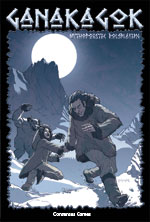This sounds interesting: a role-playing game inspired by Inuit mythology:

When people ask me what my game Ganakagok is about, I say, “It’s a fantasy.” I tell them that it’s about a people called the Nitu, who live on a starlit island of ice in a world where the sun has never risen. They live in darkness, revering the Stars, honoring their Ancestors, and marveling at the handiwork of the Forgotten Ones, who long ago wrought Ganakagok into its current form.
I had been thinking for a long time about how to use a tarot-style “oracle” in a role-playing game, because I was fascinated with the way that divination methods like tarot and the I Ching provided powerfully suggestive grist for the interpretive mill. In other words, divination methods seem to work by providing an ambiguous image of which one makes sense in the context of the current situation or problem. Because our minds are designed to see patterns, make connections, and find order, the appropriateness of the divination seems uncanny.
To make the Ganakagok tarot, I essentially “reskinned” a normal 52-card playing card deck, changing the names of the suits and the court cards to make them seem more icily primitive—Tears rather than Spades, Stars rather than Diamonds, and Ancient, Man, Woman, and Child in place of Ace, King, Queen, and Jack. Then I went back to the divinatory meanings associated with the corresponding card in a tarot deck, coming up with two “motifs” for each one, a noun phrase that I called the card’s “image” and a verb phrase that was its “meaning.” So, for example, the Ace of Spades became the Ancient of Tears, or “Polar Bear,” with the meaning “to master or overcome.” And the Two of Clubs became the Two of Storms, or “Depths of the Sea,” with the meaning, “to be troubled by the unknowable.”
– Bill White @ Flames Rising
Ganakagok @ Indie Press Revolution